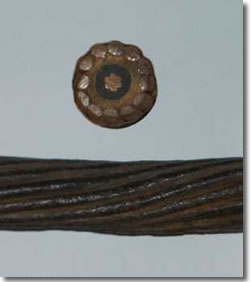The term transatlantic refers to something occurring all the way across the Atlantic Ocean. Most often, this refers to the exchange of passengers, cargo, information, or communication between North America and Europe.
Transatlantic crossings
Main article: Transatlantic flight Transatlantic flights
Transatlantic cables are cables that have been laid along the ocean floor to connect North America and Europe. Before the advent of radio, the only means of communication across the Atlantic Ocean was to physically connect the continents with a transatlantic telegraph cable, which was installed from Valentia, Ireland to Heart's Content, Newfoundland in 1858. The exchange rate between the United States dollar and British pound is still colloquially known as "cable" by financial marketeers on account of the fact the rate of exchange was one of the early uses of the transatlantic cable.
Transatlantic cables
Transatlantic radio communication was first accomplished on December 12, 1901 by Guglielmo Marconi who, using a temporary receiving station at Signal Hill, Newfoundland, received a Morse code signal representing the letter "S" sent from Poldhu, in Cornwall, United Kingdom. Marconi began the first commercial transatlantic radio service in 1907.
High frequency (HF) transatlantic radio communication was initiated 1927 and the first transatlantic telephone cable TAT-1 was installed in 1955. Satellite technology vastly increased the speed and quality of transatlantic communication, but transatlantic fiber optic cables now carry the vast majority of transatlantic communications traffic.
 Transatlantic tunnel
Transatlantic tunnel
Transatlantic cables are cables that have been laid along the ocean floor to connect North America and Europe. Before the advent of radio, the only means of communication across the Atlantic Ocean was to physically connect the continents with a transatlantic telegraph cable, which was installed from Valentia, Ireland to Heart's Content, Newfoundland in 1858. The exchange rate between the United States dollar and British pound is still colloquially known as "cable" by financial marketeers on account of the fact the rate of exchange was one of the early uses of the transatlantic cable.
Transatlantic cables
Transatlantic radio communication was first accomplished on December 12, 1901 by Guglielmo Marconi who, using a temporary receiving station at Signal Hill, Newfoundland, received a Morse code signal representing the letter "S" sent from Poldhu, in Cornwall, United Kingdom. Marconi began the first commercial transatlantic radio service in 1907.
High frequency (HF) transatlantic radio communication was initiated 1927 and the first transatlantic telephone cable TAT-1 was installed in 1955. Satellite technology vastly increased the speed and quality of transatlantic communication, but transatlantic fiber optic cables now carry the vast majority of transatlantic communications traffic.
 Transatlantic tunnel
Transatlantic tunnelMain article: Atlantic Rowing Race Transatlantic rowing race
Transatlantic rowing race
Today, some Britons and Americans use the term "crossing the pond" humorously in reference to transatlantic travel.
Transatlantic relations
Transatlantic flight
Transatlantic relations
List of islands in the Atlantic Ocean
 Transatlantic rowing race
Transatlantic rowing raceToday, some Britons and Americans use the term "crossing the pond" humorously in reference to transatlantic travel.
Transatlantic relations
Transatlantic flight
Transatlantic relations
List of islands in the Atlantic Ocean
